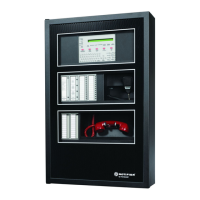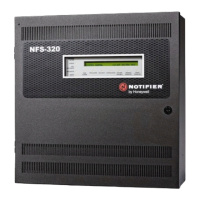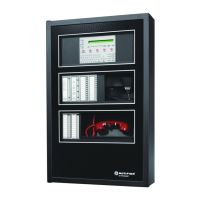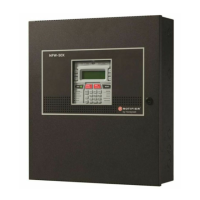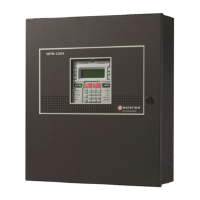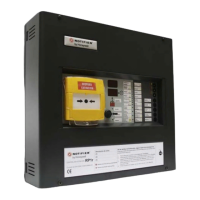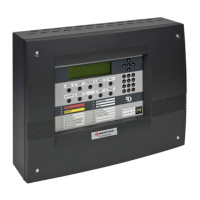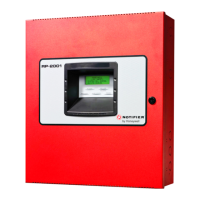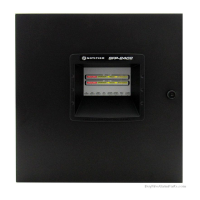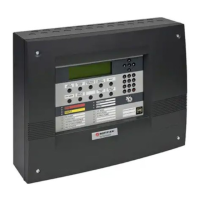Cut along dotted line.
NFS2-3030 OPERATING INSTRUCTIONS
Section 1 Operating Information
Normal Standby Operation.
1. Green P
OWER indicator lit steadily.
2. Red FIRE ALARM indicator off.
3. Yellow TROUBLE indicators off.
4. Yellow O
THER indicator off.
Alarm Condition.
1. Red FIRE ALARM and/or Yellow OTHER (for MNS alarms)
indicator(s) lit.
2. Alarm signaling devices activated.
3. Option module (remote station or supplementary alarm relay)
activated.
4. Alarm information visible on LCD (liquid crystal display).
Alarm Reset. After locating and correcting the alarm condition,
reset the control panel by pressing the S
YSTEM RESET switch. If both
Fire and MNS conditions are present on the panel, S
YSTEM RESET
must be pressed twice.
Trouble Condition. Activation of trouble signal under normal oper-
ation indicates a condition that requires immediate attention. Contact
your local service representative. Silence the audible signal by press-
ing the A
CKNOWLEDGE switch. The trouble indicator will remain illu-
minated.
Section 2 NFS2-3030 Switch Functions
Acknowledge. This silences the piezo sounder and changes all
flashing conditions to steady. It sends an acknowledge message to the
printer and history file. ACKNOWLEDGE also automatically sends a
special command to silence piezo sounders on ACS Annunciators. If
more than one event exists, it advances the display to the next item
and displays it until the A
CKNOWLEDGE switch is pressed again. Only
one press is necessary for non-fire, trouble, or supervisory signals.
Signal Silence. SIGNAL SILENCE turns off all silenceable circuits
and illuminates the S
IGNALS SILENCED indicator. It also sends a SIG-
NALS SILENCED message to the LCD, printer, and history file. A sub-
sequent alarm will then resound the system.
Notes:
1. This system is programmed to inhibit signal silence for
____seconds.
2. This system is programmed to automatically silence alarm signal
after _____ minutes.
Drill (Alarm Signal On for Canadian applications). The
NFS2-3030 waits for the D
RILL/ALARM SIGNAL ON switch to be
pressed for 2 seconds, then turns on all silenceable circuits (all control
modules/panel circuits that are programmed silenceable for fire
alarms), and turns off the S
IGNALS SILENCED LED. This event shows
on the LCD, printer, and History file.
Note: This switch is only available on NFS2-3030 with keypad/dis-
play.
System Reset. Resets the control panel in standalone applications.
Resets panel when enabled in network applications.
Lamp Test. Press and hold the switch to lamp-test the LEDs.
Section 3 LED Indicators
Controls Active. Green LED which illuminates when the NFS2-
3030 assumes control of the network primary display.
Power. Green LED which illuminates when primary power is
applied to the control panel.
Fire Alarm. Red LED that flashes when one or more alarms occur.
Illuminates steadily after alarms are acknowledged, and turns off
when SYSTEM RESET is pressed after alarm clears.
Pre-Alarm. Red LED that flashes when a pre-alarm threshold is
reached.
Security. Blue LED that illuminates for a security alarm. LED turns
off after the alarm clears and SYSTEM RESET is pressed.
Supervisory. Yellow LED that flashes when a Supervisory or Tam-
per condition occurs, such as a sprinkler valve tamper condition. The
LED illuminates steady after conditions are acknowledged, and turns
off when the conditions are cleared. The Tamper indication will latch
until S
YSTEM RESET is pushed.
System Trouble. Yellow LED that flashes when one or more trou-
bles occur. Goes on steadily when ACKNOWLEDGE is pressed, and
turns off when all trouble conditions are cleared.
Other Event. Yellow LED flashes when an MNS alarm, process
monitor, CO alarm, CO pre-alarm, hazard alert or weather alert
occurs. Goes on steadily when ACKNOWLEDGE is pressed, and turns
off when the condition is cleared. System reset required for MNS
alarms.
Signals Silenced. Yellow LED that illuminates after S
IGNALS
S
ILENCED has been pressed. Turns off when DRILL or SYSTEM RESET
is pressed.
Point Disabled. Yellow LED that illuminates when one or more
points are disabled. The LCD will indicate which points have been
disabled. Turns off when points are re-enabled.
CPU Failure. Yellow LED that illuminates if the microprocessor
fails.
Section 4 NFS2-3030 Audible Sounder
Alarm. A continuous sounding tone.
Trouble, Disable, Pre-alarm. Two beeps per second.
Supervisory. Four beeps per second.
Security. Eight beeps per second.
Section 5 Periodic Testing and Maintenance
To ensure proper and reliable operation, system inspection and testing
should be scheduled as required by the Authority Having Jurisdiction,
or as required by NFPA 72 or local fire codes. A qualified Service
Representative should perform testing.
Before Testing: Notify fire department and/or central alarm receiv-
ing station if alarm condition is transmitted. Notify facility personnel
of the test so alarm sounding devices are ignored during the test
period. Physically disconnect releasing devices.
Remote Connection Feature: ULC requires that devices such as
UDACT and TM-4 be disconnected during annual testing to prevent
transmission of false alarms.
TM-4: Slide SW4 Disable All Output switch from “Enable” to “Dis-
able.”
After Testing: Verify that remote-connection devices are turned
back on. Notify all fire, central station, and/or building personnel
when testing is complete. Re-connect releasing devices.
Section 6 Local Service Representative:
NAME: ________________________________________________
ADDRESS: _____________________________________________
TELEPHONE NUMBER: __________________________________
This sheet must be framed and mounted adjacent to the control panel.
Document 52547 Rev: C3 ECN: 16-0219 04/27/2016
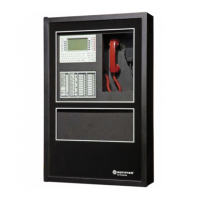
